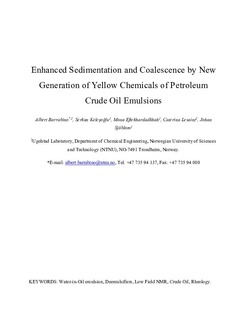| dc.contributor.author | Barrabino, Albert | |
| dc.contributor.author | Kelesoglu, Serkan | |
| dc.contributor.author | Eftekhardadkhah, Mona | |
| dc.contributor.author | Simon, Sebastien Charles | |
| dc.contributor.author | Sjøblom, Johan | |
| dc.date.accessioned | 2018-02-28T10:33:59Z | |
| dc.date.available | 2018-02-28T10:33:59Z | |
| dc.date.created | 2017-12-13T09:04:10Z | |
| dc.date.issued | 2017 | |
| dc.identifier.citation | Journal of Dispersion Science and Technology. 2017, 38 (12), 1677-1686. | nb_NO |
| dc.identifier.issn | 0193-2691 | |
| dc.identifier.uri | http://hdl.handle.net/11250/2487629 | |
| dc.description.abstract | This study compares by means of new and advanced destabilization protocols the efficiency of new chemistry environmentally friendly (yellow) demulsifiers with already commercially available red demulsifiers in destabilizing two types of water-in-oil (w/o) emulsions: petroleum crude oil emulsions and model dense packed layers (DPLs). Oil?water separation profiles were measured by low-field nuclear magnetic resonance (NMR), which allows monitoring the water content as well as the mean droplet size in the emulsion as function of the sample height and the time. Separation profiles measured by NMR depicted an increase of the free water release kinetics as the concentration of demulsifier as well as the sedimentation rate increased. The water resolution was not substantially improved by increasing the concentration further while the water quality was worse, most likely due to adsolubilization. There was no observation of DPL formation in these crude oil emulsions. Four different demulsifiers were tested on a model DPL and compared with normal crude oil emulsions. One chemical showed higher efficiency in destabilizing DPL than destabilizing crude oil emulsion. The interfacial rheological properties for one of the systems showed a slight increase in the elastic modulus (E?), as the concentration of demulsifier increased. The increment of the elastic modulus is not totally understood. The most central parameters were represented by principal component analysis (PCA). PCA did not contribute in a better characterization of the chemicals. The new-generation yellow demulsifiers did not reproduce the efficiency of commercially available, less environmentally friendly, (red) demulsifiers. | nb_NO |
| dc.language.iso | eng | nb_NO |
| dc.publisher | Taylor & Francis | nb_NO |
| dc.title | Enhanced sedimentation and coalescence of petroleum crude oil emulsions by the new generation of environmentally friendly yellow chemicals | nb_NO |
| dc.type | Journal article | nb_NO |
| dc.type | Peer reviewed | nb_NO |
| dc.description.version | acceptedVersion | nb_NO |
| dc.source.pagenumber | 1677-1686 | nb_NO |
| dc.source.volume | 38 | nb_NO |
| dc.source.journal | Journal of Dispersion Science and Technology | nb_NO |
| dc.source.issue | 12 | nb_NO |
| dc.identifier.doi | 10.1080/01932691.2015.1004410 | |
| dc.identifier.cristin | 1526557 | |
| dc.relation.project | Norges forskningsråd: 207538 | nb_NO |
| dc.description.localcode | Locked until 21.8.2018 due to copyright restrictions. This is an [Accepted Manuscript] of an article published by Taylor & Francis in [Journal of Dispersion Science and Technology] on [21 Aug 2017], available at https://www.tandfonline.com/doi/full/10.1080/01932691.2015.1004410 | nb_NO |
| cristin.unitcode | 194,66,30,0 | |
| cristin.unitname | Institutt for kjemisk prosessteknologi | |
| cristin.ispublished | true | |
| cristin.fulltext | original | |
| cristin.fulltext | postprint | |
| cristin.qualitycode | 1 | |
